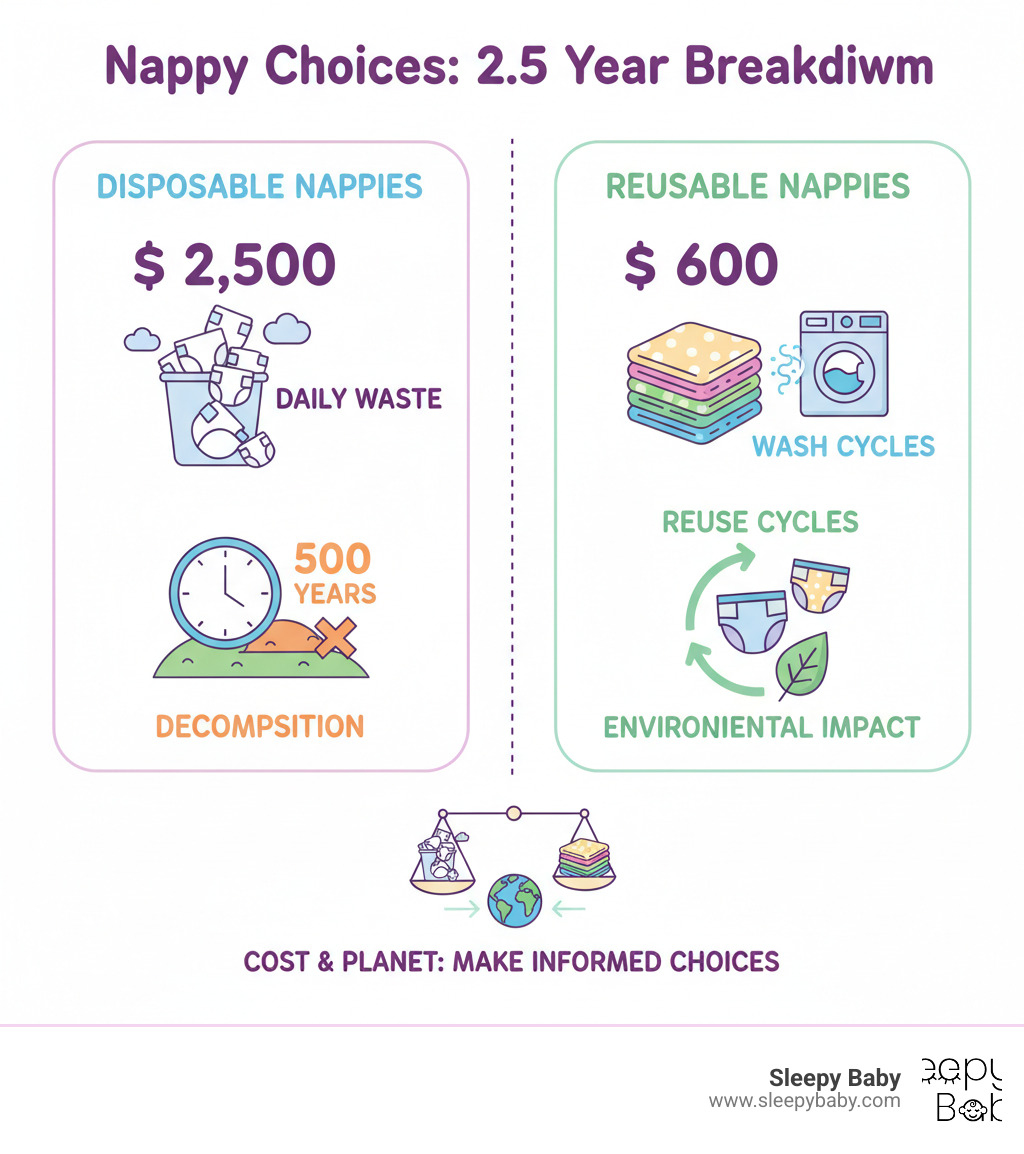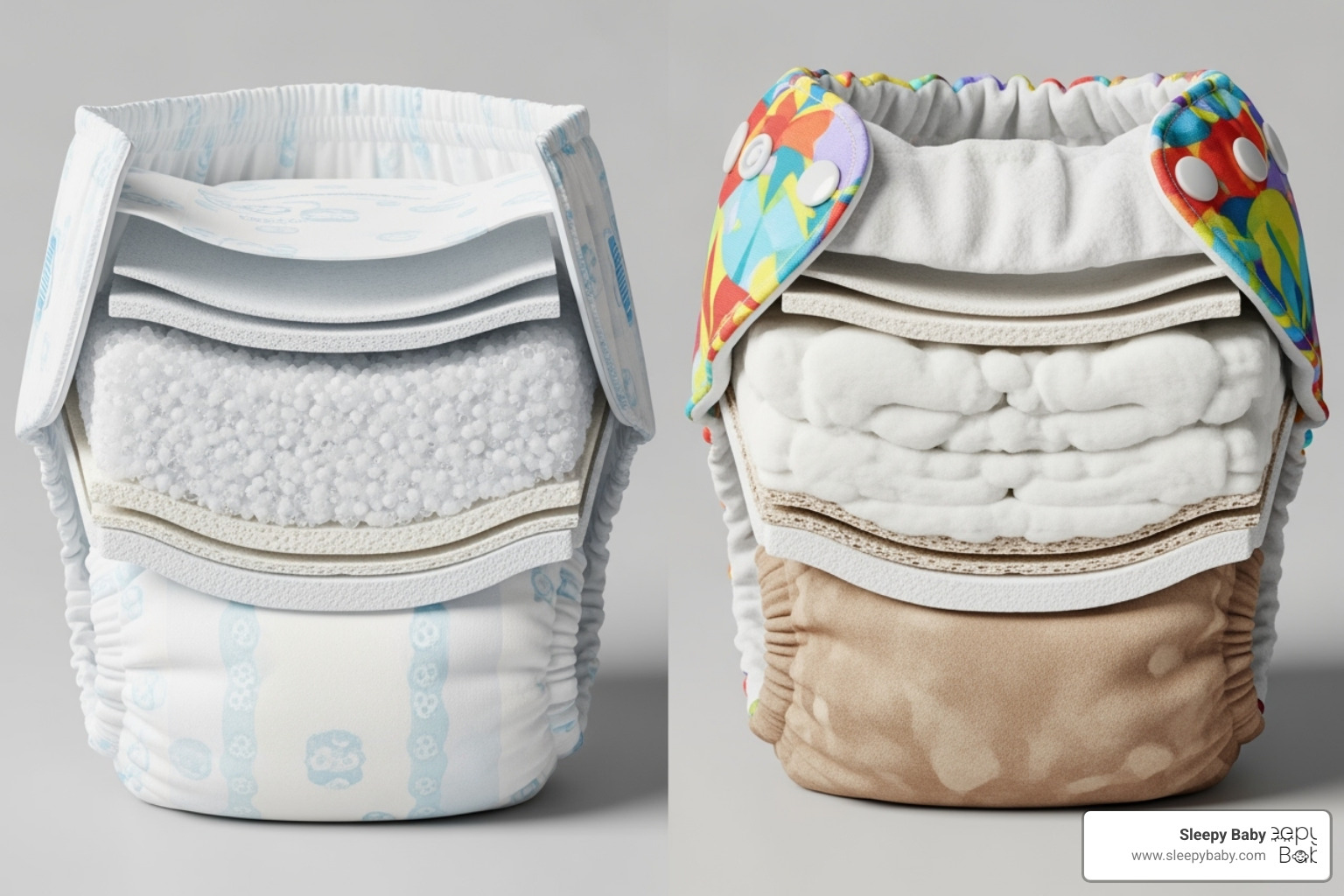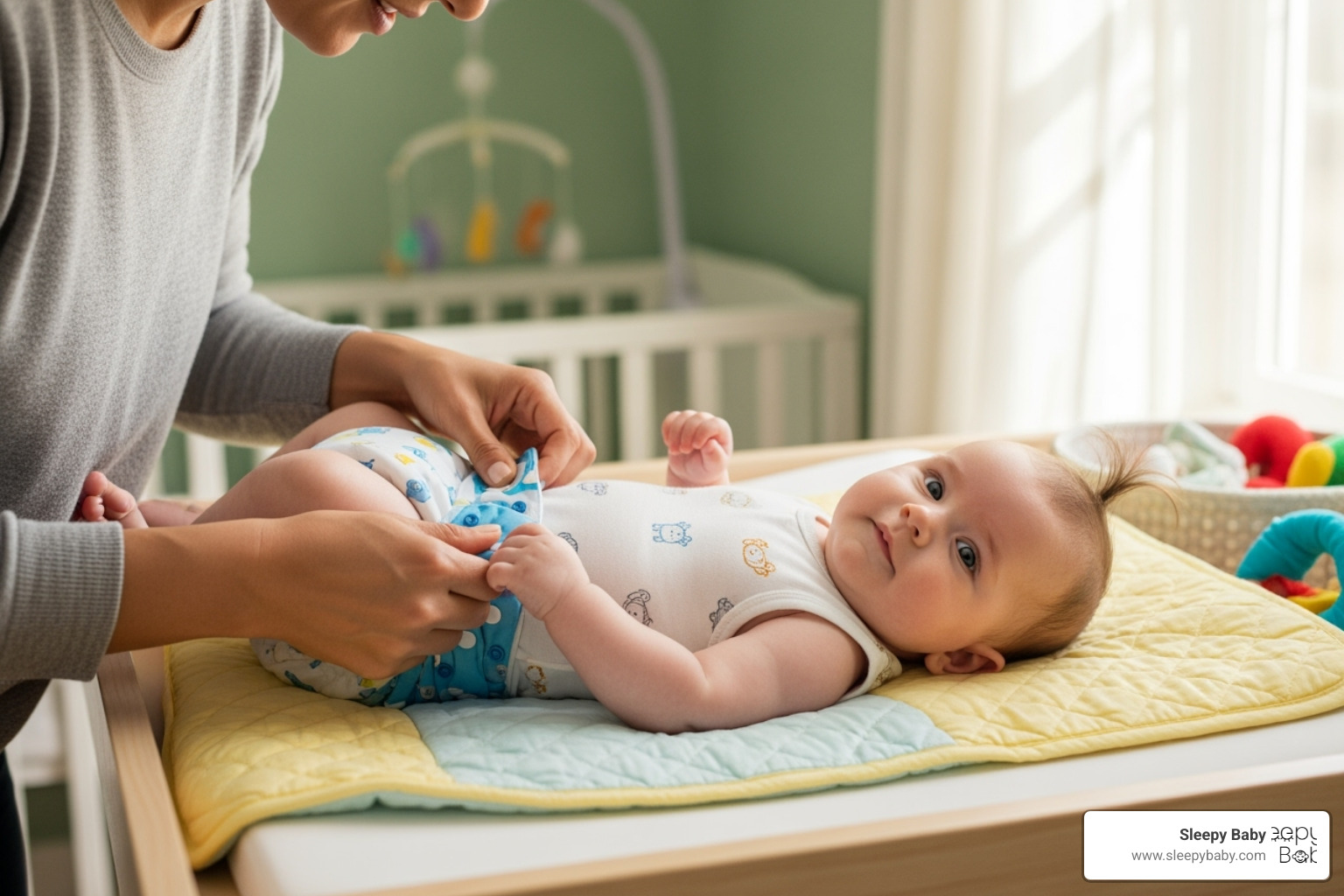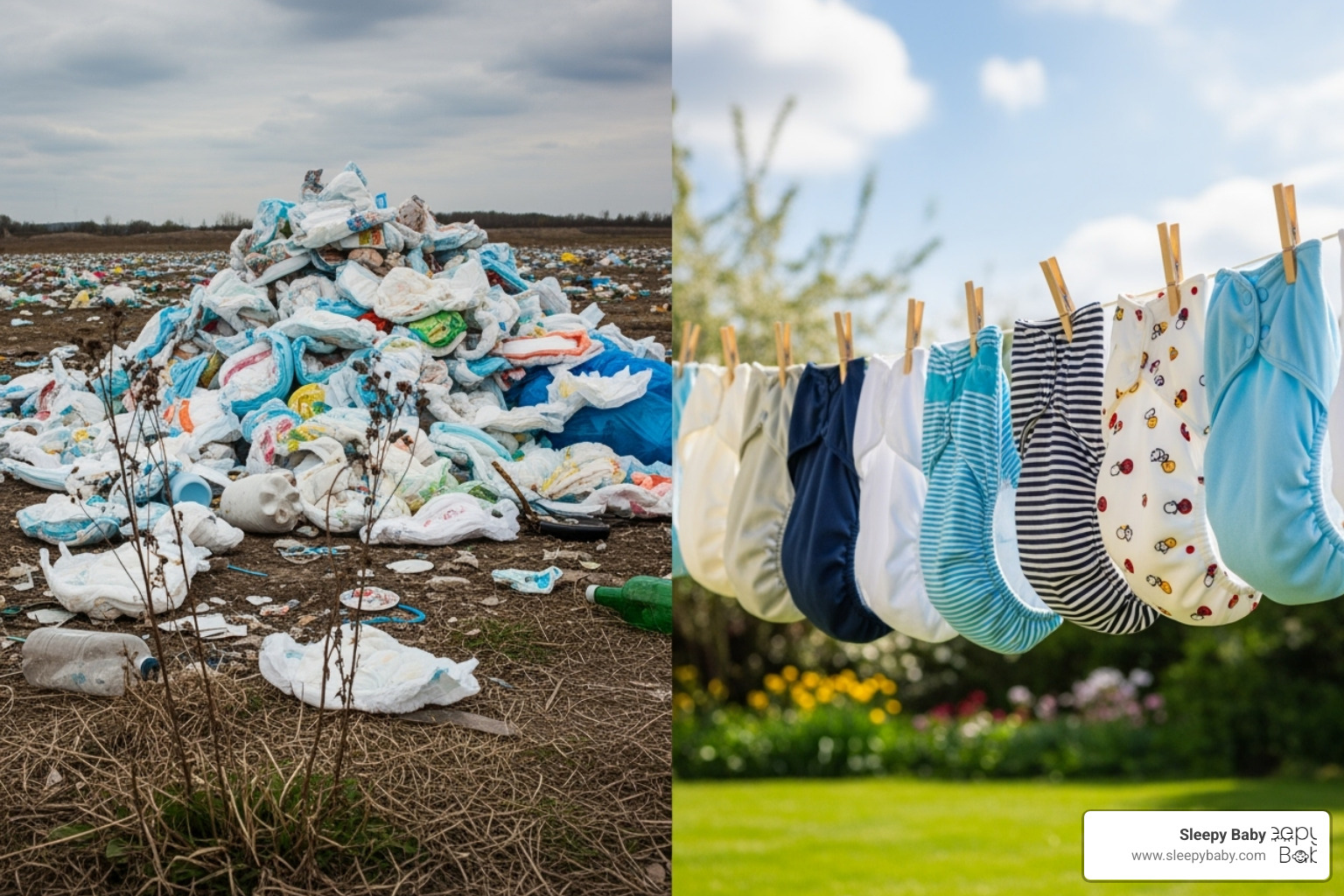The Great Nappy Debate: Making the Right Choice for Your Family
Disposable nappies vs reusable is one of the biggest decisions new parents face, with most families going through 6,000 to 7,000 nappy changes before their child is potty trained. This choice impacts your budget, daily routine, and environmental footprint.
Quick Comparison:
| Factor | Disposable Nappies | Reusable Nappies |
|---|---|---|
| Cost | $1,400-$3,000 per child | $300-$1,000 initial investment |
| Convenience | Grab-and-go, no washing | Requires washing every 2-3 days |
| Environmental Impact | 3.5 million tons of landfill waste annually | 90% lower production impact |
| Absorbency | Super-absorbent polymers | Less absorbent, more frequent changes |
| Best For | Busy lifestyles, travel | Budget-conscious, eco-friendly families |
Modern cloth nappies have evolved far beyond the terry towelling squares your grandmother used. Today's reusable options feature Velcro closures, snap fasteners, and waterproof outer layers that make them nearly as convenient as disposables. Meanwhile, disposable nappies continue to improve their absorbency and fit.
The choice often comes down to what matters most to your family: immediate convenience or long-term savings, environmental impact, and your baby's specific needs. As parents steer the overwhelming world of baby products, it becomes clear that the right choice varies for every family's unique situation.

At a Glance: Key Differences in Materials and Design
Understanding what goes into each type of nappy is crucial when weighing up disposable nappies vs reusable options. The materials and construction couldn't be more different, and these differences shape everything from performance to environmental impact.
Modern disposables are marvels of engineering designed for maximum convenience, while today's cloth nappies have evolved far beyond the bulky terry squares your mum might remember. Let's peek inside both to see what makes them tick.

The Anatomy of a Disposable Nappy
Think of a disposable nappy as a tiny, wearable sponge with serious engineering behind it. Each one contains multiple layers working together like a well-oiled machine.
The inner layer sits against your baby's skin and feels soft and dry, even when wet. This clever material lets liquid pass through but doesn't let it back up. Underneath lies the real star of the show: the absorbent core.
This core is where the magic happens. It's packed with super-absorbent polymer (SAP) - those gel crystals that can soak up many times their weight in liquid. Mixed with wood pulp, these materials create an incredibly thirsty layer that pulls moisture away from your baby's bottom.
The outer layer is made from waterproof plastic, usually polyethylene, which keeps everything contained. Elasticated legs and waistbands create a snug seal, while sticky tabs make fastening simple, even at 3am when you're half asleep.
But here's where it gets complicated. These high-tech nappies also contain plastics, adhesives, and sometimes perfumes. Some parents worry about chemicals like dioxins, though manufacturers work to keep these minimal. The trade-off for all this convenience? Each nappy takes around 500 years to break down in landfill.
The Evolution of the Reusable Nappy
If you're picturing your grandmother's cloth nappies - all safety pins and soaking buckets - think again. Modern reusable nappies have had a complete makeover and honestly, they're pretty impressive.
Today's cloth nappies accept natural fabrics that are gentle on skin and surprisingly effective. Cotton remains a favourite for its softness and breathability, while bamboo offers natural antibacterial properties and excellent absorption. Hemp is incredibly durable and gets more absorbent with each wash, and microfibre provides quick-drying convenience.
The game-changer is the waterproof outer layer made from PUL (polyurethane laminate). This breathable fabric prevents leaks while letting air circulate - no more plastic pants that made babies sweaty and uncomfortable.
Modern closures have revolutionised the changing experience. Velcro (or hook-and-loop) fasteners adjust perfectly to your baby's shape, while snaps are virtually indestructible and won't wear out over time.
The variety of modern reusable nappies means there's something for every family's needs. All-in-ones work just like disposables with everything sewn together. Pocket nappies let you stuff absorbent inserts into a waterproof shell, perfect for customising absorbency. All-in-twos have inserts that snap in and out, so you can reuse the cover if it stays clean. Prefolds offer the most budget-friendly option and work brilliantly with a separate waterproof cover.
This evolution means choosing reusable doesn't mean sacrificing convenience. Many parents find modern cloth nappies just as easy to use as disposables, with the bonus of knowing exactly what's touching their baby's skin.
The Financial Factor: A Cost Breakdown
Money talks, especially when you're budgeting for a baby. The disposable nappies vs reusable debate often comes down to dollars and cents, but the math isn't as straightforward as you might think. While disposables seem cheaper upfront, those daily purchases add up quickly over your child's diapering years.
The Upfront vs. Ongoing Cost of Disposable Nappies vs Reusable
Let's talk real numbers. Disposable nappies will cost your family between $1,400 and $3,000 for each child over 2.5 years. That's just for generic brands. If you prefer premium options or eco-friendly disposables, you're looking at $1,750 to $3,600 or more per child. The cost per nappy ranges wildly from 3.5 cents to over 80 cents, depending on the brand and size you choose.
Reusable nappies flip this equation completely. Yes, you'll face a bigger upfront investment of $300 to $1,000 for a complete system, but that's it for your diapering costs (minus washing). A basic cloth nappy kit can start as low as $180, while a comprehensive collection might reach $1,000 if you want all the bells and whistles.
Here's where the math gets really interesting. Your baby will need around 4,515 nappy changes over 2.5 years, but with cloth nappies, you only need to own about 20-24 physical nappies that you'll wash and reuse repeatedly. The savings multiply dramatically if you're planning more children, since the same set of cloth nappies can diaper multiple babies.
The second-hand market for reusable nappies is thriving, meaning you can often recoup some of your investment when you're done diapering. Try selling used disposables and see how that goes!
| Nappy Type | Cost for 1 Child (2.5 years) | Cost for 2 Children (approx.) | Notes |
|---|---|---|---|
| Disposable (Generic) | $1,400 - $3,000 | $2,800 - $6,000 | Varies by brand, size, and sales. Includes wipes/sacks. |
| Disposable (Premium/Eco) | $1,750 - $3,600+ | $3,500 - $7,200+ | Higher per-nappy cost. |
| Reusable (Washed at Home) | $300 - $1,000 | $500 - $1,200 | Initial purchase + washing costs. Significant savings for second child. |
| Reusable (Laundering Service) | $2,500 - $2,800 | $5,000 - $5,600 | Comparable to disposables, but no personal washing effort. |
Hidden Costs and Savings to Consider
The sticker price is just the beginning. Both options come with sneaky extra costs that can impact your disposable nappies vs reusable decision.
Washing costs are the main hidden expense for cloth nappies. You'll spend about 4.78 cents per nappy for a 40°C wash with budget detergent, or up to 8.21 cents per nappy if you prefer hot washes with premium products. The good news? You can toss other baby items like bibs and muslins into these loads, making each wash more efficient. Line-drying saves even more on energy costs.
Disposables bring their own surprise expenses. Disposable wipes can cost anywhere from 9 cents to 64 cents per day depending on your brand loyalty. Nappy sacks for disposal add another 8 cents daily. Don't forget about specialized diaper pails and their refill cartridges, which can quietly drain your budget over time.
The savings side of reusables offers some pleasant surprises. Nappy libraries let you test different cloth nappy styles before committing to a full set, potentially saving you from expensive mistakes. Many local councils now offer incentive schemes or vouchers for purchasing reusable nappies, recognizing their environmental benefits.
When you're putting together your baby essentials, these long-term financial implications deserve serious consideration. The numbers don't lie: cloth nappies win the financial marathon, even if disposables seem easier on your wallet at the checkout line.
Performance & Practicality: The Disposable Nappies vs Reusable Showdown
When it comes to the daily reality of diapering, the disposable nappies vs reusable debate gets real fast. We need nappies that actually work - ones that keep our babies dry, comfortable, and leak-free while fitting into our hectic lives.
The truth is, both options have stepped up their game significantly. Modern disposables boast incredible absorbency that can handle overnight stretches, while today's cloth nappies feature leak-proof barriers and user-friendly closures that make changes nearly as quick as their disposable counterparts.
But here's where things get interesting: performance isn't just about the nappy itself. It's about how well it fits into your family's rhythm, your baby's unique needs, and those inevitable 3 AM changes when you're running on two hours of sleep.

Convenience, Laundry, and Lifestyle
Let's be honest - disposable nappies win the convenience race by a mile. There's something beautifully simple about the grab-and-go approach: dirty nappy off, clean nappy on, soiled one in the bin. Done. No second thoughts, no extra steps, no mental load about wash cycles or drying times.
This convenience really shines during travel. Whether you're visiting grandparents for the weekend or taking that ambitious family holiday, disposables eliminate the worry about finding laundry facilities or packing enough clean nappies. They're travel-friendly in every sense - available everywhere, lightweight in your luggage, and requiring no storage space for dirty ones.
But modern reusable nappies have genuinely closed the convenience gap during changes themselves. Those old-school safety pins? Gone. Today's cloth nappies fasten with Velcro or snap closures that are just as quick as disposable tabs. The actual changing process feels virtually identical.
Where reusables require more effort is in the washing routine. You'll be doing an extra 2-3 loads of laundry per week, which means planning your wash cycles and staying on top of your nappy supply. The process involves dry pailing - storing soiled nappies (with any solids flushed away first) in a lidded bucket or wet bag until wash day every 2-3 days.
Many families find success with a hybrid approach. Use cloth nappies during the day when you're home and have easy access to changes, then switch to disposables for overnight, outings, or when others are caring for your baby. This strategy lets you capture some environmental and financial benefits without the full commitment to constant washing.
When you're preparing your diaper bag for those inevitable outings, having options can be a lifesaver.
The Diaper Rash Dilemma
Every parent dreads that angry red bottom, and the disposable nappies vs reusable choice can play a role in prevention - though frequent changes trump everything else.
Disposable nappies excel at keeping moisture away from your baby's skin thanks to those super-absorbent polymers. They can handle larger volumes of liquid while maintaining a relatively dry feel against the skin, which is excellent for rash prevention. The materials are also designed to be breathable, allowing air circulation that helps keep the diaper area healthy.
However, some babies develop sensitivities to the chemicals, dyes, perfumes, and plastics found in disposables. While there's no conclusive evidence of harm from these materials, they can cause irritation in babies with particularly sensitive skin. If you notice persistent redness that seems linked to your disposable brand, it might be worth trying a different manufacturer or considering alternatives.
Reusable nappies offer a chemical-free environment made from natural fabrics like cotton, bamboo, or hemp. Many parents love the soft, gentle feel against their baby's skin, and those with very sensitive babies often find cloth more comfortable. The natural materials allow excellent breathability when clean and dry.
The challenge with cloth nappies lies in their lower absorbency compared to disposables. They simply can't hold as much liquid while keeping baby feeling dry, which means more frequent changes are essential. If a wet cloth nappy sits against the skin too long, that constant moisture becomes a recipe for irritation.
There's also the washing factor to consider. Detergent allergies can sometimes contribute to rashes, and improper washing routines might leave residues that irritate sensitive skin. Getting your wash routine right is crucial for both cleanliness and comfort.
The bottom line? Whether you choose disposable nappies vs reusable, preventing diaper rash comes down to vigilant changing. Check frequently, change immediately when wet or soiled, let that little bottom air dry when possible, and use barrier creams as needed. The American Academy of Pediatrics offers excellent guidance on proper diapering techniques that work for both nappy types.
The Bigger Picture: Environmental Impact and Potty Training
Our choice between disposable nappies vs reusable extends far beyond daily convenience and cost. It touches the very heart of how we want to care for our planet and may even play a role in our child's journey to independence.

Nappies and the Planet: A Complex Comparison
When we think about the environmental impact of our nappy choice, the numbers can be overwhelming. Disposable nappies create a staggering 3.5 million tons of landfill waste annually in the United States alone. Even more sobering is that every disposable nappy ever made (unless incinerated) still exists somewhere on our planet, slowly breaking down over the course of 500 years.
The production of disposables demands enormous resources. We're talking about vast amounts of wood pulp for absorbency, petroleum for plastic components, and countless gallons of water for manufacturing. DEFRA research shows that the environmental impact of disposing a single-use nappy is nine times higher than that of a reusable nappy, while disposables use approximately 98% more resources to produce than their cloth counterparts.
But before we crown reusables as the clear environmental champion, we need to consider the full picture. Yes, choosing cloth nappies means diverting over 6,000 nappies per child from landfills—a remarkable achievement. However, reusable nappies carry their own environmental footprint, primarily during their use phase.
Every wash cycle requires clean water and energy, produces wastewater, and involves detergents that eventually enter our water systems. The efficiency of our washing machine, how we dry our nappies (tumble dryer versus line drying), and even our choice of detergent all influence the environmental impact. The UK government's lifecycle assessment study dives deep into these complexities, revealing that neither option is without environmental cost.
The rise of "eco-disposables" has added another layer to this debate. While marketed as more environmentally friendly, many still end up in landfills where conditions aren't ideal for the biodegradability they promise. It's a classic case of greenwashing that can make our decision even more challenging.
The truth is, there's no perfect environmental choice here. Both disposable nappies vs reusable have impacts, but we can minimize them through conscious decisions about how we use and care for whichever option we choose.
The Path to the Potty
Here's an interesting twist in the disposable nappies vs reusable story: your nappy choice might influence when your little one is ready for potty training, though the connection isn't as straightforward as you might think.
The theory goes like this: reusable nappies, being less absorbent than their disposable counterparts, allow babies to feel wetness more readily. This immediate feedback helps children become aware of their bodily functions and the discomfort that follows. For babies who are particularly bothered by feeling wet, cloth nappies could provide the motivation to start showing interest in the potty earlier.
On the flip side, disposable nappies are so incredibly absorbent that babies often remain feeling dry even after they've urinated. While this is fantastic for comfort and preventing nappy rash, it can delay their awareness of being wet, potentially making the transition to potty training feel less urgent from their perspective.
But here's where expert opinion comes in with a reality check: child development is key. Most pediatric specialists agree that the type of nappy we use has minimal impact on potty training success. The most crucial factors are whether our child is physically, emotionally, and cognitively ready for this milestone, combined with our approach as parents.
Potty training happens when children are developmentally prepared, regardless of whether they've been wearing cloth or disposables. Some children trained in disposables are ready at 18 months, while others in cloth nappies might not show interest until they're three. Every child follows their own timeline.
The good news is that both nappy types work perfectly well during the potty training transition. Many parents find that training pants—often reusable—serve as a helpful bridge between nappies and underwear, giving children more independence while still providing some protection during those inevitable accidents.
Making Your Choice: What's Right for Your Family?
The disposable nappies vs reusable decision isn't one that comes with a universal right answer. What works perfectly for your neighbor might feel overwhelming for your family, and that's completely okay. After weighing all the factors we've discussed—from costs and convenience to environmental impact and your baby's comfort—the best choice is ultimately the one that fits your unique circumstances and values.
Some families thrive with the grab-and-go convenience of disposables, especially during those chaotic newborn months when every minute of saved time feels precious. Others find deep satisfaction in the ritual of caring for reusable nappies, knowing they're making a long-term investment in both their budget and the planet. Many find that a combination approach works beautifully, using cloth at home and disposables for outings or overnight.
The beauty of modern parenting is that we have options, and there's no need to feel guilty about whichever path makes the most sense for your family.
Key Factors to Consider for the Disposable Nappies vs Reusable Decision
When making this important decision, it helps to honestly assess what matters most to your family right now. Your budget considerations play a huge role—can you manage the higher upfront cost of reusables for long-term savings, or does spreading costs over time with disposables work better for your current situation?
Your lifestyle and available time matter enormously too. If you're already juggling work, other children, or health challenges, adding 2-3 extra loads of laundry each week might feel overwhelming. On the flip side, if you enjoy having control over what touches your baby's skin and don't mind the washing routine, reusables might feel like a natural fit.
Environmental values often influence this choice significantly. Some parents feel strongly about reducing landfill waste, while others prioritize the water and energy conservation that comes with fewer washing loads. Neither approach is perfect environmentally, so consider which trade-offs align better with your family's values.
Your baby's individual needs should guide you too. Some little ones have sensitive skin that reacts to disposable materials, while others get rashes more easily when they feel wetness from cloth nappies. Pay attention to what keeps your baby most comfortable.
Finally, consider your family planning. If you're hoping for more children, that initial investment in reusable nappies becomes increasingly worthwhile with each subsequent baby.
Finding Your Perfect Nappy and Sleep Solution
Whatever you decide in the disposable nappies vs reusable debate, a comfortable, well-rested baby is the ultimate goal. When your little one feels secure and content—whether in cloth or disposables—they're more likely to sleep peacefully, which means better rest for everyone.
At Sleepy Baby, we understand that good sleep often starts with comfort. Our portable sleep aids complement whatever nappy choice you make by providing that extra layer of soothing your baby might need. The gentle rhythmic patting mimics your comforting touch, helping babies learn to settle independently while you take care of other important tasks—like washing those cloth nappies or restocking your disposable supply.
While some white noise machines can present safety concerns, modern safety-rated devices deliver soothing sounds at safe, low-decibel levels. Some can even be placed directly on your baby's chest for maximum comfort. Combined with rhythmic tapping technology, these tools help create the perfect environment for restful sleep, regardless of your nappy choice.
The journey of parenthood is filled with countless decisions, and the nappy debate is just one of many. Trust your instincts, stay flexible as your needs change, and remember that the "right" choice is simply the one that works for your family today.
Explore more tips for new parents on our blog for guidance on creating peaceful sleep routines and navigating other parenting decisions with confidence.



